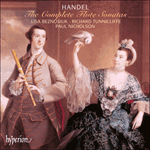It may have begun life as an oboe sonata, but at its higher pitch (the oboe version is in C minor) the opening Adagio lies perfectly for the flute’s most eloquent range, suited to its dipping lines and artful modulations. By contrast, the second movement’s main theme, treated initially with strict canonic imitation in the continuo, is chromatic and full of awkward intervals, one of Handel’s typically arresting fugal themes—he was not a composer who, like Bach, was content with a cliché subject that he could work elaborately and ingeniously. The music runs off every now and then into semiquaver passagework, but it is the chromatic theme that gives the movement its unusual character. The brief Grave that follows shows much elaboration of the melodic line, and simplification of the bass, compared with earlier treatments of the same ideas; the broad sweep of the phrases works happily on the flute. The final minuet, although its most direct source is a harpsichord suite, has strong echoes (its bass especially) in the minuet of the G major section of the
Water Music.
from notes by Stanley Sadie © 2001
Le premier mouvement, Adagio, a peut-être été écrit pour hautbois à l’origine, mais sa version plus aiguë (celle pour hautbois est en
ut mineur) convient à merveille au registre le plus éloquent de la flûte, adapté à ses lignes plongeantes et à ses habiles modulations. Bien différent, le thème principal du deuxième mouvement, traité au départ en une stricte imitation canonique au continuo, est chromatique et multiplie les intervalles périlleux; c’est un de ces sujets de fugue à la séduction typiquement haendélienne—Haendel n’était pas Bach qui pouvait se contenter d’un sujet banal et le pousser jusque dans ses derniers retranchements de la manière la plus ingénieuse. Des traits de virtuosité en doubles croches ponctuent cette page ici et là, mais c’est le thème chromatique qui donne à ce mouvement son caractère inhabituel. Dans le bref
Grave qui suit, la ligne mélodique est beaucoup plus travaillée et la basse beaucoup plus simplifiée que lors de précédents traitements de ces mêmes idées; les vastes courbes de ces phrases sont parfaites pour la flûte. La source la plus directe du menuet final a beau être une suite pour clavecin, il n’en présente pas moins une forte parenté (à la basse surtout) avec le menuet de la section en
sol majeur de la
Water music.
extrait des notes rédigées par Stanley Sadie © 2001
Français: Josée Bégaud
Sie mag als Oboensonate entstanden sein, doch in dieser höheren Tonlage (die Fassung für Oboe ist in c-Moll) steht das einleitende Adagio perfekt in der ausdrucksvollsten Lage der Flöte, die sich für die hier verlangten wogenden Melodielinien und kunstvollen Modulationen eignet. Im Gegensatz dazu ist das Hauptthema des zweiten Satzes, das anfangs mit strenger kanonischer Imitation im Continuo geführt wird, chromatisch und voller schwieriger Intervalle, eines von Händels typisch auffälligen fugalen Themen—er war keiner jener Komponisten, die wie beispielsweise Bach mit einem klischeehaften Subjekt zufrieden sind, das sie dann kunstvoll und geistreich bearbeiten können. Die Musik verläuft sich gelegentlich in Sechzehntel-Passagenwerk, doch es ist das chromatische Thema, das dem Satz seinen außergewöhnlichen Charakter verleiht. Das folgende knappe Grave zeugt, verglichen mit vorhergehenden Umsetzungen der gleichen Ideen, von viel Ausarbeitung der Melodielinie und Vereinfachung im Baß; der breite Fluß der Phrasen kommt der Flöte entgegen. Das abschließende Menuett mag sein Material unmittelbar aus einer Cembalosuite beziehen, doch es hat auch starke Anklänge an das Menuett im G-Dur-Abschnitt der
Wassermusik (besonders im Baß).
aus dem Begleittext von Stanley Sadie © 2001
Deutsch: Anne Steeb/Bernd Müller


 Handel: The Complete Flute Sonatas
Handel: The Complete Flute Sonatas
